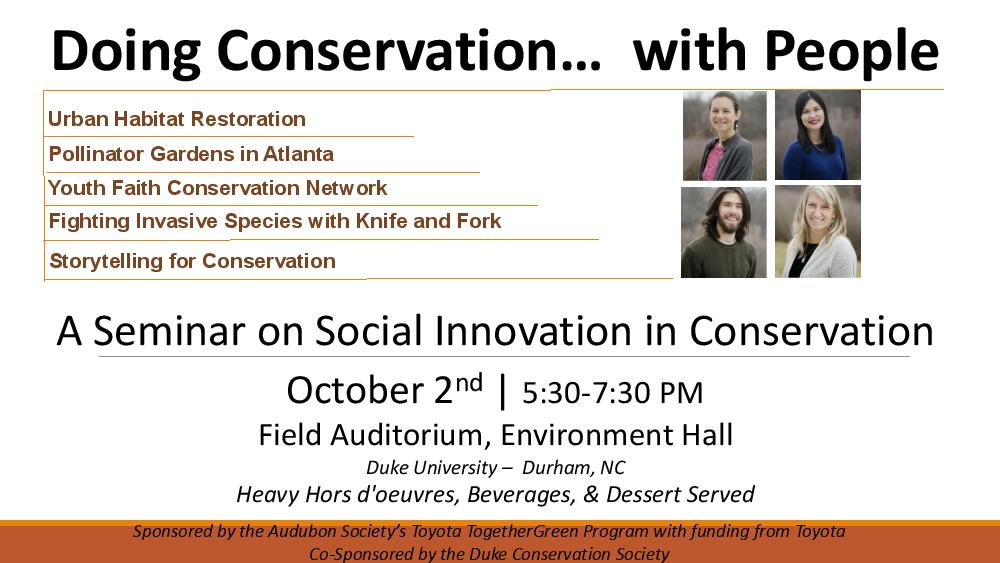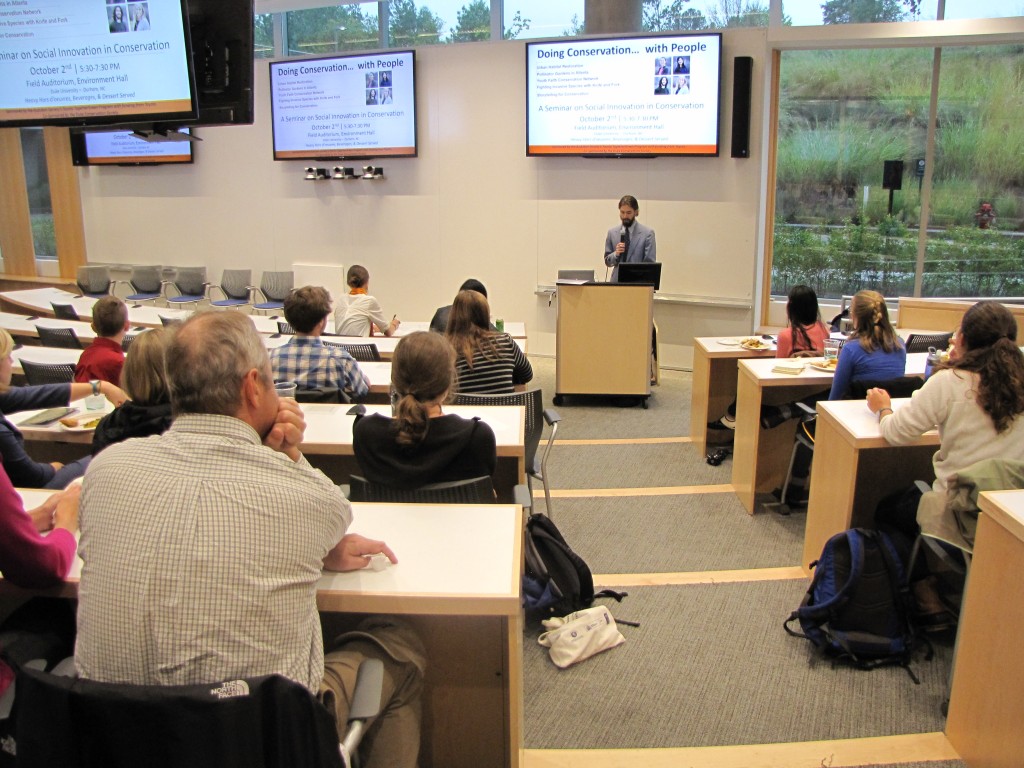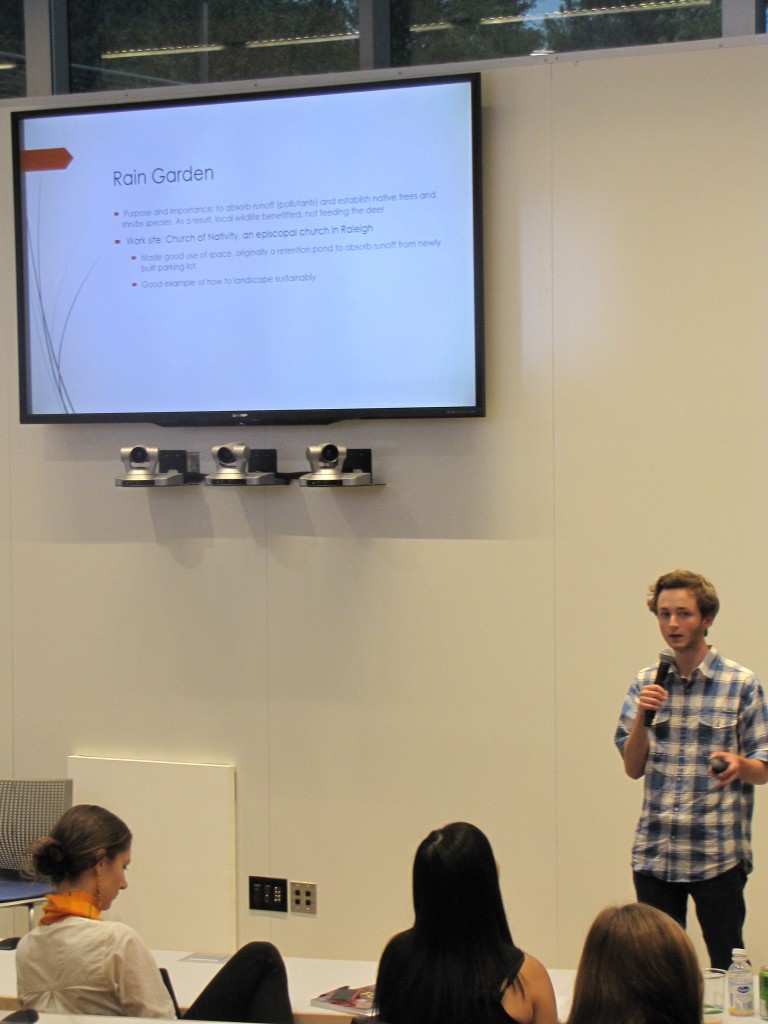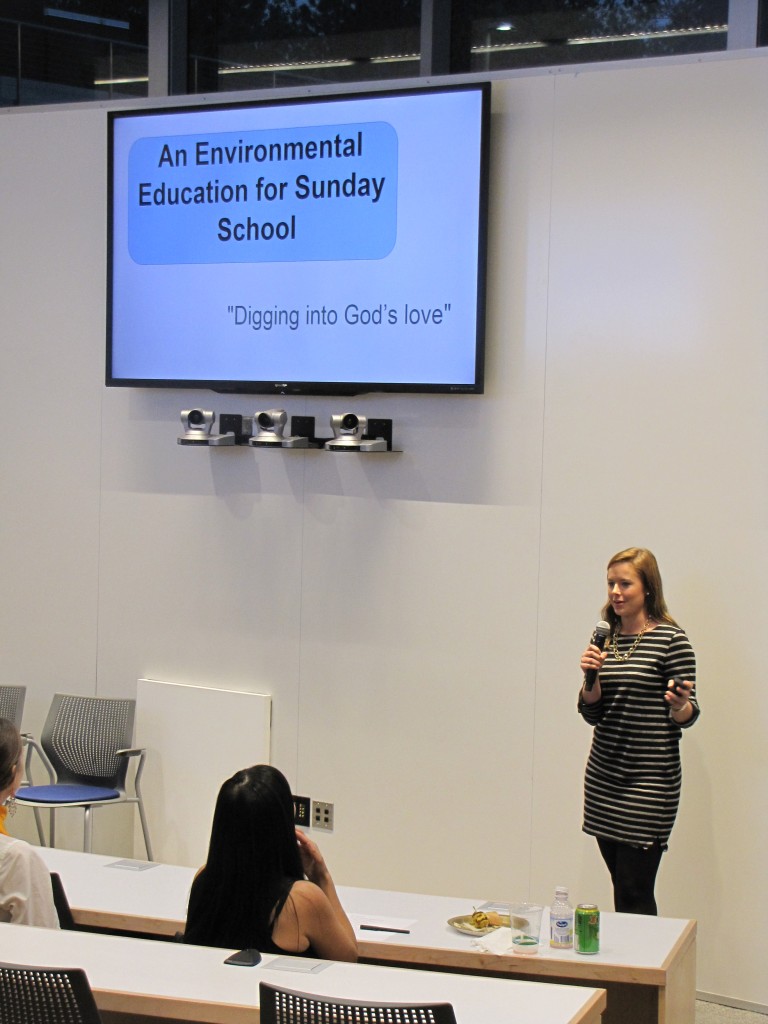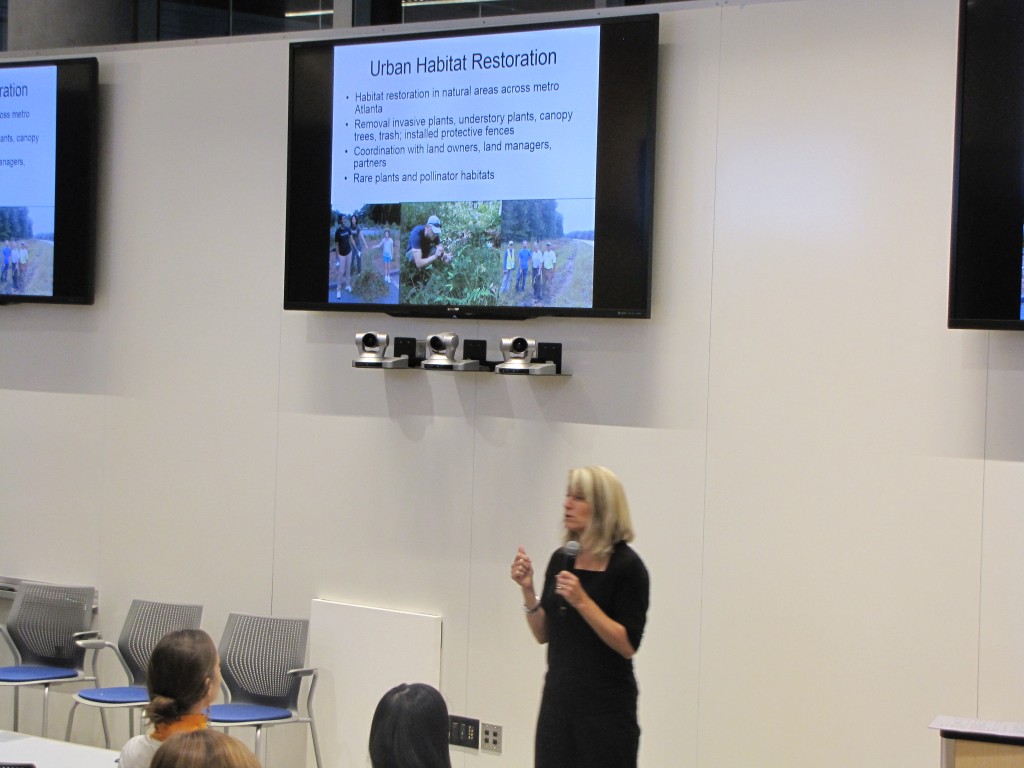View the Recorded Seminar here:
goo.gl/rYhMe4
An evening of sharing new innovations, focusing on:
Conservation projects extending the social reach of the conservation field
Sponsored by the Audubon Society’s Toyota TogetherGreen (TTG) Program with funding from Toyota and a 2015 TTG Alumni Grant
Co-Sponsored by the Duke Conservation Society
Social Innovation in Conservation in Review
A guide to the seminar
| Page # | Time | Presenters | TTG Affiliation | organization name: |
| 3 | 0:00 | Dave Grace | TTG Fellow | Youth Faith Conservation Network (YFCN) |
| 4 | 10:36 | Owen Clapp | Participant | YFCN |
| 6 | 17:07 | Tara Mei Smith | TTG Grantee | Extra Terrestrial Projects |
| 9 | 28:08 | Edward Landi | Participant | YFCN |
| 11 | 39:18 | Mary Todd Earnhardt | Participant | YFCN |
| 13 | 46:12 | Jennifer Cruse-Sanders | TTG Fellow | Atlanta Botanical Garden |
| Page # | Presenter | Presentation/Project Description |
| 3 | Dave Grace | Intro to TTG social innovation in conservation |
| 4 | Owen Clapp | Organizing a church for solar |
| 6 | Tara Mei Smith | Engaging NYC millennials in wildlife / native habitat projects |
| 9 | Edward Landi | Church rain garden & Brown headed Nuthatch nesting boxes |
| 11 | Mary Todd Earnhardt | Wildlife Sunday school curriculum |
| 13 | Jennifer Cruse-Sanders | Pollinator Gardens and Urban Habitat |
Presenter content summarized as follows:
Time | Presenter
TTG Affiliation & Organization name
Words of Wisdom
Projects Discussed
Motivation
0:00 Dave Grace
TTG Fellow, Youth Faith Conservation Network
Words of wisdom:
“…someone [the Pope] who can meet with Kim Davis, the Kentucky Clerk, and also garner this wide attention on climate change is important, I think, and I think it is important as we listen to these projects to think about how we can use this idea of cultural narrative or political narrative to inform our efforts and to coordinate among multiple stakeholders, and I will also say — as we listen to the projects — in themselves they are an instance of multi-level stakeholder coordination as we are working in the auspices of Audubon and it’s larger network” -Dave Grace
Projects Discussed:
Dave Grace offered preliminary remarks, attempting to relate the social and physical geographies of the seminar’s TTG projects to a contemporary, global conservation context.
Motivation:
The focus of these remarks was to pose the increasing interrelation of social and ecological problems, given pressing conservation problems such as climate change, and to point to the importance of cultural narrative in facilitating social innovation in conservation.
10:36 Owen Clapp
Project leader, Youth Faith Conservation Network
Student- High School Senior
Words of wisdom:
“Focus on the values that we all share within the faith community. The values that are deep rooted in not just the Christian faiths but other faiths as well. the respect for the environment in things such as the Bible… looking at those values that we all share and reminding people that’s our true cause to do these things for God… so taking those values that we all share and keeping everyone happy but keeping people connected on the true purpose of what we are trying to accomplish.”
[in response to a question about agenda setting for conservation in a church context]
Projects Discussed:
- Two children friendly additions to a church community garden (previous)
- Organizing for solar energy at Western Boulevard Presbyterian Church (YFCN)
Motivation
- “Together we’ve been working to bring faith communities conservation projects which can change the world” – Owen Clapp
2. “There’s biofuels there’s fossil fuels but solar is the basis of it all, it all goes back to solar… that’s why I chose solar for the church” – Owen Clapp
17:07 Tara Mei Smith
TTG Grantee, Extra Terrestrial Projects
Tara Mei Smith, founder of Extra Terrestrial Projects in New York, NY, spoke about how this project removes edible invasive species from local habitats by putting them on the table. Her project aims to involve NYC millennials in the conservation of native habitats and wildlife migration pathways.
Words of wisdom:
“thinking about social innovation it’s important to think about how to create an experience of transformation, if you have a cause or an idea and you’re trying to get people to look at in a new way, the most important thing is that they have a transformative experience.”
Projects Discussed:
- “Plant Magic: Prospect Park Plant, Pull and Picnic” May 30 2015
-Partner(s): Tama Wong, Forager/Author
Description: A hike and picnic with group-gathered invasive species
- Native plant walk in the Catskills
-Partner(s): Catskills Conservation Corps, John Shapiro, Musician
Description: Hike, invasive species pull, invasive species ID, interacting with electro-resistivity sounds with plants
- BEEN TRAIL
-Partner(s): Black roses running Crew
Description: “Fast foraging” – a race w/ different running crews to see who can ID the most invasive species.
- Native bird hut
-Partner(s) Prospect Park Band Shell (holds 7-9k people)
Description: a native bird hut at a concert, functioned to sign up 200 people to go birding
Ex. hawk watching at Fort Tilden
- Full Moon Horseshoe Ritual June 14, 15 8pm
-Partner(s): shamanic practitioners in training, two Audubon Wildlife Biologists, Cornell Cooperative Extension Citizen Science Project
Description: a spirit animal activity, horseshoe crab biology talk, citizen science on spawning horseshoe crabs”
- Spartina Grass planting in Jamaica Bay – June 22, 2014, noon-4
-Partner(s) – American Littoral Society
Description: volunteer recruitment and participation in first community led restoration project to restore marshes, involving a day of grass planting followed by a dance party
- Hopscotch music festival
-Partner(s): NC botanical garden
Description: a midnight native plant sale
Motivation
- “giving people opportunity to identify invasive species, identify native plants, and also taste them, so hopefully all 3 processes will help them remember a little more.”
- “one thing we realized after doing…[prospect park picnic], is that, even though people really enjoyed eating the invasive species they didn’t remember how to identify them”
“The mission of the organization is to connect with people who are outside of the traditional environmental movement. For the most part, for people that are coming it’s a completely novel experience for them… for the most part it seems like entertainment which is exciting… it’s like complete discovery.”
[In response about the environmental involvement of participants in Extra Terrestrial Projects]
“I think this idea of craft conservation projects around the country could happen, that’s the hope at least”
[In response to a question about the scalability of Extra Terrestrial Projects]
“This year we are focusing on invasive species. One of the reasons were doing this, with climate change, invasive species become more and more of a problem”
“Plants and trees cant more very fast… there’s this ecological problem but trying to think of a way where we can fit it in with a cultural opportunity”
“You never know where you might find new spaces for conservation”
28:08 Edward Landi
Project leader, Youth Faith Conservation Network
Student- Undergraduate, 1st year
Words of wisdom:
“A lot of what conservation has to do with is sustainability, figuring out how to use a resource without destroying it and how to use it sustainably”
Projects Discussed (YFCN):
- Rain Garden
-Partner(s): Church of the Nativity Episcopal, North Carolina Interfaith Power and Light
Description: native plants wildlife and runoff filtration
- Brown-headed Nuthatch Nesting Boxes
-Partner(s): Western Boulevard Presbyterian Church, Church of the Nativity
Description: Donation of 50 Brown-headed Nuthatch Nesting Boxes to faith communities and member households. Engagement in monitoring
Projects Discussed (Other)
- Bird Conservation
-Partner(s): NC Natural Science Museum
Description: Bird banding, study skin creation, radio telemetry
Motivation
- “[the] purpose was to provide habitat for wildlife and also a place to absorb pollutants”
- “Audubon NC is having a campaign where by 2015 they are trying to set up 10,000 nesting boxes for the brown-headed nuthatch…. [the] nuthatch is a species of concern… better safe than sorry… make sure bird does not decline so it doesn’t become like the endangered red-cockaded woodpecker”
- “…important to figure out about an environmental catastrophe… if there’s an influx of seabirds for instance and you can see that they all have plastic in stomach, it’s a good way of saying hey there is something going on here. It’s pretty much a really good snapshot and historical reference for what the bird life was at a locality and it can be used by scientists to reference data. It’s a really good resource for scientists to use as well… the museum itself has 24k specimens in its collection so i helped prepare those specimens by stuffing birds.
39:18 Mary Todd Earnhardt
Project leader, Youth Faith Conservation Network
Student- High School Senior
Words of wisdom:
“You haven’t been molded yet when you’re young. Society has a way of molding you into the norm and the regular things that we fall into, and at that young age they have so many new and innovative ideas that I think we really need to hear and respect more and yea they are kids they are going to say some crazy things but some of them… they are going to be crazy good things. Also, their enthusiasm. They have a new approach and a fresh attitude. I think that is something we can all look forward to and mimic in our projects.” Mary Todd Earnhardt
[in response to a question about helpful qualities of youth in conservation projects]
Project Discussed (YFCN):
- Digging into God’s Love– Wildlife Curriculum for Sunday school
-Partner(s): Western Boulevard Presbyterian Church
Description: A “4 week Sunday school curriculum that educates students grades 1st to 3rd in ways to care for God’s Creation, stories in which God showed his love for the Earth and inspire students to go out into the world with Christian hearts and green thumbs”
Motivation
“I wanted to base my project around kids, like I said I go to Sunday school a lot, and every year they introduce a new curriculum so I wanted to start a curriculum where we got to talk about the environment because I feel like we talk about stories and human interaction so much but in the Bible there are some many times where God introduces nature into this and I feel like it gets overlooked too much”
46:12 Jennifer Cruse-Sanders
TTG Fellow, Vice President for Science and Conservation (Atlanta Botanical Garden)
Jennifer Cruse-Sanders spoke about the urban habitat restoration project she founded with the garden. The project engages local students in removing invasive species and enhancing pollinator habitats at five wetland areas around Atlanta.
Words of wisdom:
“The gate for us to connect with people and those [urban] habitats is pollinator gardens, if you can connect people to pollinator gardens, you can teach them about native plants, sources of native plants, and all other sorts of types of environmental health issues.” Jenny Cruse-Sanders
Project Discussed (YFCN):
Partner(s) – Conservation Fund, Audubon Atlanta, Greening Youth Foundation, USFWS, West Atlanta Watershed Alliance, Trees Atlanta, USFS
- Urban Habitat Restoration
Description: “in 2011, we got some initial funding to do urban habitat restoration… and it opened up a whole new set of partners and opportunities”
“recently we’ve been working on whole community conservation… so wetlands of the long leaf pine ecosystem where orchids and pitcher pants grow, those are the habitats for those really, really cool plants and…. many species of orchids and pitcher plants grow in the SE US.”
- Pollinator Gardens
Description: Various
- Greater Atlanta Pollinator Partnership: “in 2009, the forest service started this idea” gapp.org
“We’ve worked with students as part of the urban habitat restoration. We go into schools and work with students to create pollinator habitat.”
- “Lindsay Street Park is the first park for the English Avenue neighborhood within Proctor Creek Watershed.”
Pollinator garden planting Oct 17
Park ribbon cutting Oct 21
Park pollinator festival Oct 28
- next step: connect Lindsay Street Park with Vine City Park (owned by city of Atlanta
Work with community to create a pollinator corridor between the two parks
Porch pollinator gardens, sidewalk pollinator gardens, working with the community groups, we don’t know if it will be successful, we want to try it. It could be a way of connecting the neighborhoods too.
- Other
- “we bring people into the garden to think about endangered species and conservation”
- conservation training with the Greening Youth Foundation
- workforce development program (on 5 acre urban farm) → growing milkweed with youth corps that will be used for pollinator habitat in parks
Motivation:
- “What I wanted to do is think about how we could bring in new audiences and build interest in this of creating pollinator habitat in Atlanta.”
- “The gate for us to connect with people and those [urban] habitats is pollinator gardens, if you can connect people to pollinator gardens, you can teach them about native plants, sources of native plants, and all other sorts of types of environmental health issues.
- Twenty-five mile radius around Atlanta, how much pollinator habitat can we create in there.
Seminar Attendees
Master of environmental management students at the Nicholas School of the Environment
Students in other departments at Duke University
Community partners (participants and partners from in TTG projects).

